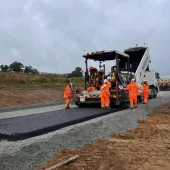Paving the Way Towards Sustainable Roads - Five steps to drive action

First published in the January 2022 issue of Quarry Management
By David Markham, senior manager - asphalt technology, Tarmac
In the aftermath of the COP26 summit and an increased focus on the climate emergency, there is growing pressure on local authorities and network operators to drive decarbonization.
As a necessary part of our infrastructure, greener highway construction and maintenance is becoming an ever-greater priority in the transition to net zero. The question is, how can materials providers, contractors, and highways clients continue to make positive change, minimize public disruption, and reduce the carbon footprint of highways delivery?
From our experience, there are five steps that can deliver more sustainable roads.
Step one
Step one is to start with asphalt and use lower-carbon materials. Whilst it may seem like an obvious point that lower-carbon materials are more sustainable, the potential benefits of these alternatives should not be underestimated.
Warm-mix asphalts (WMA) are a key surfacing material that can help our highways move towards net-zero targets. This material is manufactured and supplied at lower temperatures than conventional methods and, therefore, the embodied carbon in its production is up to 15% less than traditional hot-mix asphalt.
Additionally, the technology can drive productivity on site due to the decrease in the amount of time needed to cool to trafficking temperature. This means roads can be opened for use sooner, reducing disruption to drivers and the associated financial and carbon costs. Over the last decade, several forward-thinking local authorities have adopted the material in their efforts to meet climate goals.
That said, there is a lot of opportunity for improvement, which has been recognized by the All-Party Parliamentary Group (APPG) on Highways. Whereas nearly 50% of asphalt laid in the US uses this eco-friendly technology, that falls to just 6% in the UK. If all asphalt production in Great Britain was switched to WMA, the carbon savings would be the equivalent of cutting almost 300 million miles of car journeys.
Step two
The second step is to use recycled content where possible. It is becoming more widely understood that to achieve long-lasting climate stability, it is essential we move towards a circular economy. This is about evolving from our current throw-away economy to one in which waste is eliminated, and using recovered materials in preference to raw materials.
Highways surfacing offers significant opportunity to follow this principle, particularly as old asphalt can be fully recycled into new asphalt.
Across the country, a new generation of asphalt plants are opening which have the ability to incorporate higher levels of reclaimed asphalt planings (RAP) into asphalt mixes, reducing the requirement for primary materials.
Another option is to reuse waste materials from other industries, for example end-of-life car tyres in rubber-modified asphalt (RMA). This recycling technique in a product Tarmac have recently adopted uses approximately 500 tyres per kilometre on a two-lane single carriageway, helping to increase the functional lifespan of some of the 40 million waste tyres generated in the UK each year.
RMA can be combined with RAP and other secondary materials, such as steel slag aggregate, to further increase our industry’s sustainability efforts. In April, Tarmac became the first in the UK to receive BBA HAPAS Clause 942 approval for their Ultipave-R RMA thin-surfacing solution.
Step three
When specifying and using materials, opt for less. Leaps in innovation and technology have enabled highways teams to use high-performance asphalts that can be laid more thinly than traditional methods allow. We are now able to use single-layer surfacing technologies which are proven to deliver long-term durability alongside increased productivity on site.
This has a twofold benefit on reducing carbon emissions; less asphalt is needed per kilometre, which, in turn, reduces emissions from inbound and outbound transportation.
Despite this, many in the industry are reluctant to embrace these new technologies. Those that hold back tend to be cautious about alternatives to traditional asphalts or worry about departing from established technical specifications. Some cite misconceptions about cost as reasons to hesitate with this innovative technology. This is misguided as initial costs, often considered in isolation, do not account for the extended durability or environmental gains of single-layer surfacing.
Step four
Step four is building for the future, not just the now. A key concern we see more and more is ensuring the durability of roads. The simple fact is that the more often roads need to be repaired, the more carbon intensive they will be.
Above all else is the need to choose the right material for the right road, taking into account those that are susceptible to specific issues such as seasonal expansion and contraction or traffic-induced movement. New, advanced solutions are giving designers an alternative to deep reconstruction of pavements, which is expensive and disruptive, or simply to accepting a ‘sticking plaster’ approach.
For example, polymer-modified asphalts are excellent at enhancing road surfaces and boosting crack resistance – meaning their increased durability requires fewer interventions and maintenance than other materials. They can be one of the many solutions to extend the life of the pavement surface and break the costly cycle of repeated failure and remedial maintenance.
By building roads right first time round, highways teams can promote the longevity of roads, reducing driver disruption and potential carbon costs further down the line.
Step five
Step five is taking a step back to look at the bigger picture. It is all too easy to get bogged down in the details of asphalt specification. To achieve true sustainability is to take a holistic approach to our road infrastructure. How can the choices we make for our highways have wider-reaching benefits for our environment and society?
Warm-mix asphalts can again be part of the solution, as the lower asphalt temperatures also reduce fumes and steam on site by approximately 90%. This means better visibility and improved safety during night-time and winter working. Additionally, air quality is improved for site workers and nearby communities.
Another way to build sustainably is to encourage more sustainable road usage for the public. By choosing to use distinctively coloured asphalts for cycleways, we can encourage behavioural change and help to reduce people’s reliance on the private car. Clearly defined cycleways lead to safer cycleways, giving road users more confidence to use them instead of cars.
It is important to take a holistic approach to making our roads more sustainable. We must consider what choices we can make to help others operate more sustainably, not just within our own teams.
Behavioural change for better roads
The quarrying, asphalt, and highways industries have already made significant progress towards the delivery of sustainable roads, but we must ensure not to plateau in our efforts.
These five steps require behavioural change across all levels of the industry – from material producers to clients. We should not be afraid to challenge long-standing traditional practices, as increasingly better technology and greener solutions are not only readily available, but also already proven through widespread use.
The technologies discussed here are not new or untested, but proven examples of building roads with asphalt technology that are low in carbon, high in performance, and essential to help reach climate targets.
Tarmac have launched a new ‘Guide to sustainable road building’ – an online framework designed to support those involved in specifying and maintaining the UK’s crucial network of roads and highways. To find out more, visit: https://tarmac.com/guide-to-sustainable-road-building
- Subscribe to Quarry Management, the monthly journal for the mineral products industry, to read articles before they appear on Agg-Net.com








